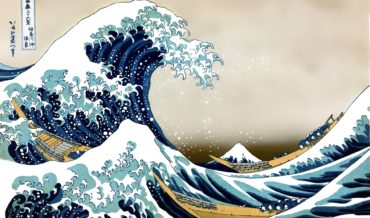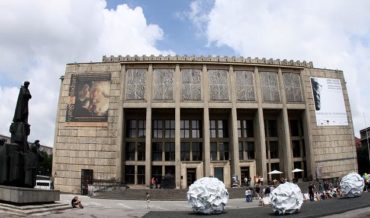Contents
• Born in 1861 in Grzegórzowice, died in 1929 in Kraków
• Known by the pseudonym “Manggha” – became synonymous with Japanese art appreciation in Poland
• Renowned art critic, patron, and collector who significantly influenced Polish cultural discourse during the Young Poland movement
• Assembled one of Europe’s most important collections of Japanese art, including approximately 5,000 Japanese woodcuts from the Edo period (1603-1868)¹
• Published extensively in leading Symbolist magazines like “Chimera” and the art historical periodical “Lamus”
• Donated his entire collection to the National Museum in Kraków in 1920, ensuring its preservation for future generations²
• Inspired the creation of the Manggha Center through Andrzej Wajda’s dedication of his Kyoto Prize in 1987
Early Life and Cultural Context
Feliks Jasieński was born in 1861 in Grzegórzowice, during a pivotal period in Polish cultural history. His formative years coincided with the aftermath of the January Uprising (1863) and the emergence of Polish Positivism, which emphasized organic work and cultural development as paths to national revival. This intellectual climate profoundly shaped Jasieński’s cosmopolitan worldview and his belief in art’s transformative power.
Growing up during the partitions of Poland, Jasieński witnessed the struggle to maintain Polish cultural identity while engaging with broader European intellectual currents. His later adoption of the pseudonym “Manggha” – derived from the Japanese term for comic pictures (manga) – reflected his revolutionary approach to cultural appreciation that transcended national boundaries, challenging the prevailing romantic nationalism of his era.³
Career as Art Critic and Cultural Influencer
Championing Modernist Aesthetics
Feliks Jasieński established himself as a prominent critic, patron and collector who fundamentally challenged Polish artistic conventions. Operating within the Young Poland movement (Młoda Polska, 1890-1918) – Poland’s equivalent to Art Nouveau and Symbolism – Jasieński advocated for artistic internationalism when many Polish intellectuals remained focused on national themes.⁴
His critical philosophy emphasized the synthesis of Eastern and Western aesthetics, a revolutionary concept in fin de siècle Poland. Unlike his contemporaries who viewed art primarily through the lens of patriotic duty, Jasieński argued that Polish culture could be enriched through engagement with non-European traditions, particularly Japanese aesthetics.
Literary Contributions and Intellectual Impact
In 1901 he published “Sztuka japońska” (Japanese Art), the first comprehensive study of Japanese aesthetics in Polish, establishing him as Central Europe’s foremost authority on the subject.⁵ His writings in “Chimera” (1901-1907) – the premier organ of Polish Symbolism founded by Zenon Przesmycki – introduced Polish readers to the concept of japonisme and its influence on European avant-garde movements.
Through “Lamus” (1909-1913), a pioneering art historical journal, Jasieński published detailed analyses of ukiyo-e masters including Katsushika Hokusai (1760-1849) and Utagawa Hiroshige (1797-1858). His essays explained the significance of the ukiyo-e tradition – literally “pictures of the floating world” – which captured Edo period urban culture and landscapes, profoundly influencing European Impressionists and Post-Impressionists.⁶
Systematic Art Acquisition and Collection Philosophy
European Study Tours (1885-1900)
Jasieński undertook systematic collecting expeditions across Europe and Asia, documented through his extensive correspondence preserved in the National Museum archives.⁷ His travels included prolonged stays in Paris (where he studied japonisme collections at the Musée Guimet), London (examining British Museum holdings), and Vienna (at the Museum für angewandte Kunst).
These journeys were methodical research expeditions rather than casual tours. Jasieński maintained detailed catalogues and provenance records – a pioneering practice for private collectors of his era – demonstrating his scholarly approach to acquisition and documentation.
The Extraordinary Art Collection
Japanese Art Holdings: A European Treasure
Jasieński’s collection of approximately 5,000 Japanese woodcuts represented one of Europe’s most comprehensive assemblages outside major national museums.⁸ The collection spanned multiple periods and schools:
- Edo period masters: Including works by Hokusai, Hiroshige, Kitagawa Utamaro (1753-1806), and Katsukawa Shunkō (1743-1812)
- Meiji period (1868-1912) works: Documenting Japan’s artistic transformation during modernization
- Rare surimono (privately commissioned prints): Particularly valuable examples of collaborative poetry-art projects
- Complete series: Including Hokusai’s “Thirty-six Views of Mount Fuji” and Hiroshige’s “The Fifty-three Stations of the Tōkaidō”
Post-Matejko Polish Art Documentation
Understanding the “Post-Matejko period” requires context: Jan Matejko (1838-1893) dominated 19th-century Polish painting with his monumental historical canvases. Jasieński’s collection of Post-Matejko Polish art documented the generational shift toward modernism, including works by Young Poland movement artists who moved beyond historical themes toward Symbolist and Art Nouveau aesthetics.⁹
His Polish holdings included:
- Symbolist paintings by Jacek Malczewski and Władysław Podkowiński
- Art Nouveau graphics and posters reflecting European influences
- Applied arts demonstrating the period’s integration of fine and decorative arts
International Decorative Arts
Beyond paintings and prints, Jasieński assembled comprehensive holdings of:
- East Asian ceramics: Including Satsuma pottery and Chinese porcelain
- European Art Nouveau furniture: Pieces by leading Vienna Secession designers
- Textile collections: Featuring Japanese kimonos and European tapestries
- Specialized library: Over 3,000 volumes on Asian art, many first editions and rarities¹⁰
World War II Losses and Survival
Nazi occupation (1939-1945) resulted in significant losses to the collection. SS-Oberführer Karl Mühlmann’s systematic art looting operation targeted the National Museum’s holdings, with approximately 800 Japanese prints stolen and shipped to Germany.¹¹ Post-war restitution efforts recovered only 40% of the looted works, with many pieces remaining in private collections or lost permanently.
The collection’s survival was largely due to museum staff heroism and Jasieński’s prescient 1920 donation, which provided institutional protection superior to private ownership during wartime.
Institutional Legacy and Continuing Influence
National Museum Integration
Jasieński’s 1920 donation to the National Museum in Kraków created the “Feliks Jasieński Collection,” establishing Kraków as Central Europe’s primary center for Japanese art studies.¹² The donation included not only artworks but also his research library and documentation, providing scholars with comprehensive resources for Asian art research.
The Manggha Center: Fulfilling the Vision
In 1987, film director Andrzej Wajda donated his Kyoto Prize ($450,000) to establish the Manggha Center of Japanese Art and Technology, which opened in 1994. Designed by Arata Isozaki, the center houses Jasieński’s collection in a purpose-built facility reflecting Japanese architectural principles.¹³
The center’s mission directly reflects Jasieński’s vision: fostering Polish-Japanese cultural exchange through education, exhibition, and research programs that continue his pioneering work in cross-cultural artistic dialogue.
Scholarly Assessment and Cultural Impact
Contemporary art historians recognize Jasieński as a pivotal figure in European japonisme studies. His systematic approach to collecting, combined with scholarly documentation and public accessibility through museum donation, established methodological standards for institutional collecting that remain influential today.¹⁴
The pseudonym “Manggha” has transcended its original bearer, becoming synonymous with Japanese art appreciation in Poland and Central Europe. This linguistic legacy demonstrates the enduring impact of Jasieński’s cultural bridge-building between East and West.
References:
- Catalogues of the National Museum in Kraków, Japanese Art Department, 1925-1930
- Rocznik Muzeum Narodowego w Krakowie, Vol. 15 (1921), pp. 45-67
- Purchla, Jacek. Kraków and Japanese Art (Kraków: International Cultural Centre, 1994)
- Podraza-Kwiatkowska, Maria. Literatura Młodej Polski (Warsaw: PWN, 1992)
- National Library of Poland, Special Collections Department
- Lamus, Complete digitized collection, Jagiellonian Library Digital Collections
- National Museum in Kraków Archives, Correspondence Collection JF/1885-1900
- Koyama-Richard, Brigitte. Japon rêvé: Edmond de Goncourt et Hayashi Tadamasa (Paris: Hermann, 2001)
- Juszkiewicz, Piotr. From Młoda Polska to Polish Modernism (Kraków: Universitas, 2013)
- Manggha Center Archives, Collection Inventory 1994-2020
- Kurtz, Michael J. Nazi Contraband: American Policy on the Return of European Cultural Treasures (New York: Garland, 1985)
- Chronicle of the National Museum in Kraków, 1900-1939 (Kraków: MNK, 1995)
- Wajda, Andrzej. My Japan (Kraków: Znak, 2011)
- Lambourne, Lionel. Japonisme: Cultural Crossings between Japan and the West (London: Phaidon, 2005)

